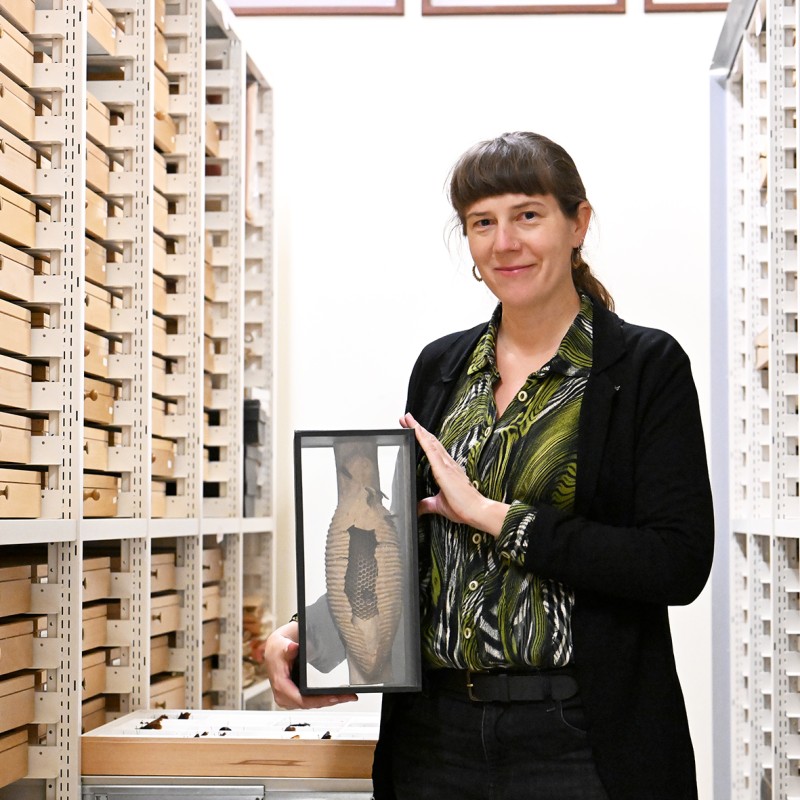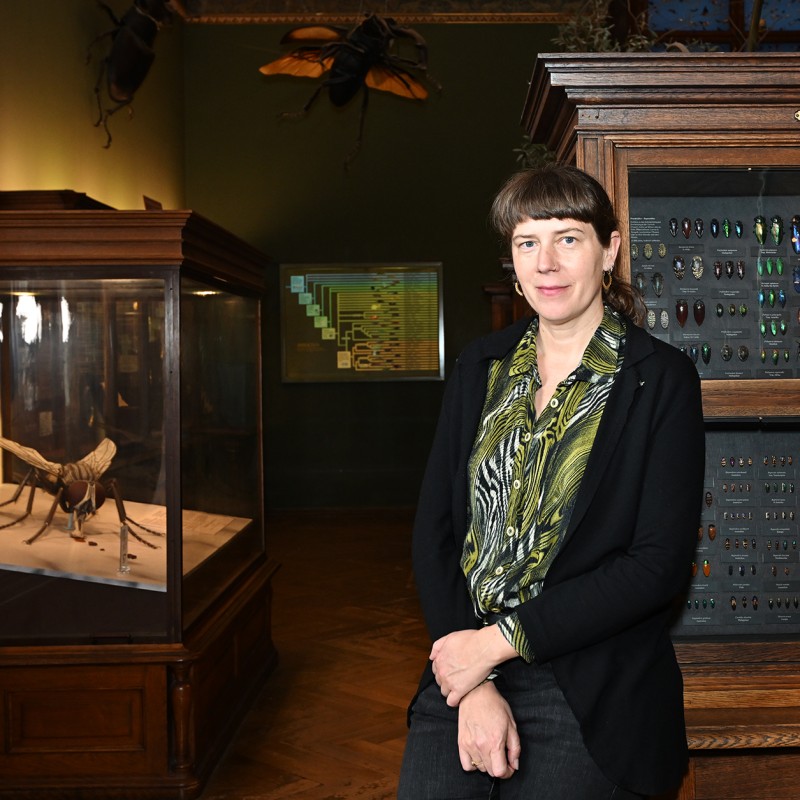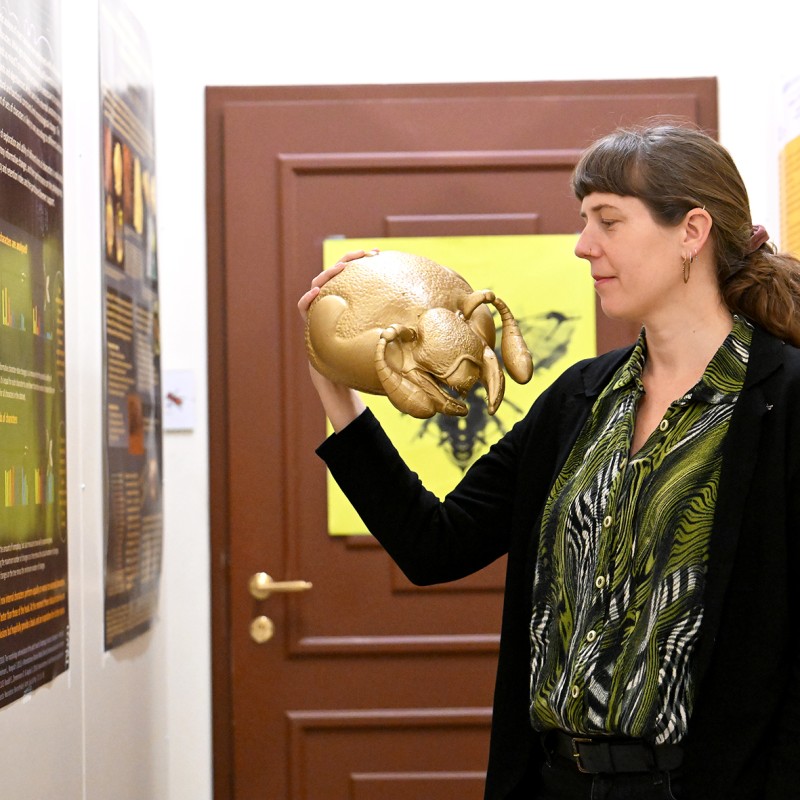Book presentation: "Insect whispers. About the hidden life on six legs" by Dominique Zimmermann
27. March 2024
Did you know that there are slave-holding ants and that termites build their nests with
air conditioning and grow fungi in them? That insects migrate south for the winter and produce extremely potent and painful
poison?
These and many other incredible facts can be found in Dominique Zimmermann's new book "Insect whispers. About the hidden life on six legs", published by Leykam Verlag.
These and many other incredible facts can be found in Dominique Zimmermann's new book "Insect whispers. About the hidden life on six legs", published by Leykam Verlag.
The author is the curator of the Hymenoptera Collection
at the Natural History Museum in Vienna and dedicates her latest work to people who see life in miniature. Incidentally, a
beetle was recently named after the busy insect researcher. Her credo: Let's deal with insects. Because without them, we humans
wouldn't exist!
Their biodiversity and numbers exceed those of all other animals on land. So they are not our inconspicuous fellow inhabitants on this planet - they are the majority. And as such, they play a crucial role in our ecosystem. We can learn a lot from them: from architecture and biodiversity to altruism. Knowledge and empathy are needed to ensure harmony between humans and nature. There is only one world for all living beings: Let's preserve it!
The book presentation will take place on Wednesday, 17 April 2024, at 18:30 at the NHM Vienna.
Programme
Greetings
Dr. Katrin Vohland, Generaldirektorin NHM Wien
About the book and the author
Prof. Dr. Michael Ohl, Museum für Naturkunde Berlin
In dialogue: How do insects influence our lives?
Ines Méhu-Blantar (Head of Deck 50, Science Communication) and Dr Dominique Zimmermann (author and curator), both NHM Vienna
Dominique Zimmermann in the prologue to her new book:
Insects remain hidden from most people. Only sometimes do they make a brief appearance. For example, when the buzzing of a mosquito robs us of sleep at night, when the hectic zig-zag flight of a wasp unsettles us at a picnic or when we dispose of a packet of rice because a moth is crawling out of it.
But these representatives, who disregard the rules of good behaviour, are only marginal phenomena - a tiny proportion of an unimaginable diversity. Insects are the most diverse group of organisms on earth. With over a million scientifically described species, our knowledge of them is rich, as is our ignorance, with many more species yet to be discovered.
Each species has its place in the world, its niche that has developed in the course of evolution, and fulfils tasks that make our planet the incredible place that it is. At the Natural History Museum Vienna, insects are anything but hidden. The scientific collection comprises around thirteen million individuals. Here I am responsible for the hymenoptera, i.e. bees, wasps and ants. My job is to organise them, preserve them, research them and make them accessible to the public. Collections of dead, needled insects could give the impression that they are no longer up to date. But the opposite is the case. They are the subject of active research into many of the challenges currently facing our society.
They are archives of biodiversity and - alongside nature itself - the most important place to explore the biodiversity of the creatures we share the earth with. Scientists discover new species here, describe them and help to record their actual diversity along with their exact locations. This enables them to determine which areas need to be protected most urgently.
The collections are windows into the past that allow us to understand how the distribution of species has developed in relation to changes in the environment. In this way, it has been possible to demonstrate the decline in their diversity in recent decades in some parts of the world. In addition to the decline in biomass, the loss of species accounts for the current insect extinction. It is a symptom of the global biodiversity crisis, which, together with the climate crisis, is one of the greatest dangers we are currently facing.
Join me on a journey into the fascinating world of insects, where we will encounter breeches bees, glide over the mountains with monarch butterflies and hoverflies, observe praying mantises lying in wait and admire the colourful metallic iridescence of golden wasps. Insects are all around us, in the meadow, in the forest and in the city, but their voice is more like a whisper. If we listen carefully and engage with this little-known world, we will discover the many ways in which they influence the earth's ecosystem, which is the basis of our lives, and how we in turn influence their existence.
I am convinced that it is enriching for everyone to engage with this life in miniature. This book is a declaration of love to all six-legged creatures and an appeal to recognise insects as living beings, to protect their habitats and to preserve the biodiversity of the planet as best we can.
It is divided into two parts. The first deals with personal and scientific approaches to insects, their diversity and incredibly large biomass, fascinating phenomena such as insect migrations and the architecture of termite structures. The final part deals with my special field of research, the world of Hymenoptera. The second part focusses on the reality of insect life in the present day, explains the causes of their extinction and explains why this affects us directly. It deals with the questions of how humans and insects can live together in harmony and how we can use empathy to find new ways of working for an earth where there is room for everyone.
In my stories, I draw on many of the research findings, thoughts and insights of others. I have endeavoured to make them largely visible in the references and thus enable interested parties to immerse themselves in a topic. Many of the thoughts on what is going wrong and what we can do better are not new ideas either. Many people are researching or working on implementing them, be it in the garden, in the neighbourhood*, in the National Council or in the EU Commission. I can only touch on many areas here, whereas an entire book could be written on each of them. Nevertheless, I hope that you will find my journey through the world of insects enriching and that it will make a small contribution to the visibility and protection of these little-known creatures. After all, we are more likely to develop a deep appreciation for the things we come into contact with and the will to preserve them.
Dominique Zimmermann, born in Vienna in 1981, is an entomologist and curator at the Natural History Museum in Vienna. Her research focusses on wild bees and other stinging insects, in particular the decline in species and its causes. She also teaches at the University of Vienna. Zimmermann is co-author of the Insect Manifesto, which will be immortalised in 13 floor slabs in front of the University of Natural Resources and Life Sciences in 2023 as part of the "Walk of Insects" artwork by Austrian artist Edgar Honetschläger. Science communication is a particular concern of hers, which she pursues as a board member of the GoBugsGo association, among other things.
Aviso:
From 8 to 20 May 2024, the Department of Science Communication at the NHM Vienna is offering the topic "Meadow, insects, flower visitors" at the Family and Open Lab Tracks.
Details can be found here: www.nhm.at/veranstaltungsprogramm
Review copy: roxana@wolkenlos-agentur.at
Their biodiversity and numbers exceed those of all other animals on land. So they are not our inconspicuous fellow inhabitants on this planet - they are the majority. And as such, they play a crucial role in our ecosystem. We can learn a lot from them: from architecture and biodiversity to altruism. Knowledge and empathy are needed to ensure harmony between humans and nature. There is only one world for all living beings: Let's preserve it!
The book presentation will take place on Wednesday, 17 April 2024, at 18:30 at the NHM Vienna.
Programme
Greetings
Dr. Katrin Vohland, Generaldirektorin NHM Wien
About the book and the author
Prof. Dr. Michael Ohl, Museum für Naturkunde Berlin
In dialogue: How do insects influence our lives?
Ines Méhu-Blantar (Head of Deck 50, Science Communication) and Dr Dominique Zimmermann (author and curator), both NHM Vienna
Dominique Zimmermann in the prologue to her new book:
Insects remain hidden from most people. Only sometimes do they make a brief appearance. For example, when the buzzing of a mosquito robs us of sleep at night, when the hectic zig-zag flight of a wasp unsettles us at a picnic or when we dispose of a packet of rice because a moth is crawling out of it.
But these representatives, who disregard the rules of good behaviour, are only marginal phenomena - a tiny proportion of an unimaginable diversity. Insects are the most diverse group of organisms on earth. With over a million scientifically described species, our knowledge of them is rich, as is our ignorance, with many more species yet to be discovered.
Each species has its place in the world, its niche that has developed in the course of evolution, and fulfils tasks that make our planet the incredible place that it is. At the Natural History Museum Vienna, insects are anything but hidden. The scientific collection comprises around thirteen million individuals. Here I am responsible for the hymenoptera, i.e. bees, wasps and ants. My job is to organise them, preserve them, research them and make them accessible to the public. Collections of dead, needled insects could give the impression that they are no longer up to date. But the opposite is the case. They are the subject of active research into many of the challenges currently facing our society.
They are archives of biodiversity and - alongside nature itself - the most important place to explore the biodiversity of the creatures we share the earth with. Scientists discover new species here, describe them and help to record their actual diversity along with their exact locations. This enables them to determine which areas need to be protected most urgently.
The collections are windows into the past that allow us to understand how the distribution of species has developed in relation to changes in the environment. In this way, it has been possible to demonstrate the decline in their diversity in recent decades in some parts of the world. In addition to the decline in biomass, the loss of species accounts for the current insect extinction. It is a symptom of the global biodiversity crisis, which, together with the climate crisis, is one of the greatest dangers we are currently facing.
Join me on a journey into the fascinating world of insects, where we will encounter breeches bees, glide over the mountains with monarch butterflies and hoverflies, observe praying mantises lying in wait and admire the colourful metallic iridescence of golden wasps. Insects are all around us, in the meadow, in the forest and in the city, but their voice is more like a whisper. If we listen carefully and engage with this little-known world, we will discover the many ways in which they influence the earth's ecosystem, which is the basis of our lives, and how we in turn influence their existence.
I am convinced that it is enriching for everyone to engage with this life in miniature. This book is a declaration of love to all six-legged creatures and an appeal to recognise insects as living beings, to protect their habitats and to preserve the biodiversity of the planet as best we can.
It is divided into two parts. The first deals with personal and scientific approaches to insects, their diversity and incredibly large biomass, fascinating phenomena such as insect migrations and the architecture of termite structures. The final part deals with my special field of research, the world of Hymenoptera. The second part focusses on the reality of insect life in the present day, explains the causes of their extinction and explains why this affects us directly. It deals with the questions of how humans and insects can live together in harmony and how we can use empathy to find new ways of working for an earth where there is room for everyone.
In my stories, I draw on many of the research findings, thoughts and insights of others. I have endeavoured to make them largely visible in the references and thus enable interested parties to immerse themselves in a topic. Many of the thoughts on what is going wrong and what we can do better are not new ideas either. Many people are researching or working on implementing them, be it in the garden, in the neighbourhood*, in the National Council or in the EU Commission. I can only touch on many areas here, whereas an entire book could be written on each of them. Nevertheless, I hope that you will find my journey through the world of insects enriching and that it will make a small contribution to the visibility and protection of these little-known creatures. After all, we are more likely to develop a deep appreciation for the things we come into contact with and the will to preserve them.
Dominique Zimmermann, born in Vienna in 1981, is an entomologist and curator at the Natural History Museum in Vienna. Her research focusses on wild bees and other stinging insects, in particular the decline in species and its causes. She also teaches at the University of Vienna. Zimmermann is co-author of the Insect Manifesto, which will be immortalised in 13 floor slabs in front of the University of Natural Resources and Life Sciences in 2023 as part of the "Walk of Insects" artwork by Austrian artist Edgar Honetschläger. Science communication is a particular concern of hers, which she pursues as a board member of the GoBugsGo association, among other things.
Aviso:
From 8 to 20 May 2024, the Department of Science Communication at the NHM Vienna is offering the topic "Meadow, insects, flower visitors" at the Family and Open Lab Tracks.
Details can be found here: www.nhm.at/veranstaltungsprogramm
Review copy: roxana@wolkenlos-agentur.at




